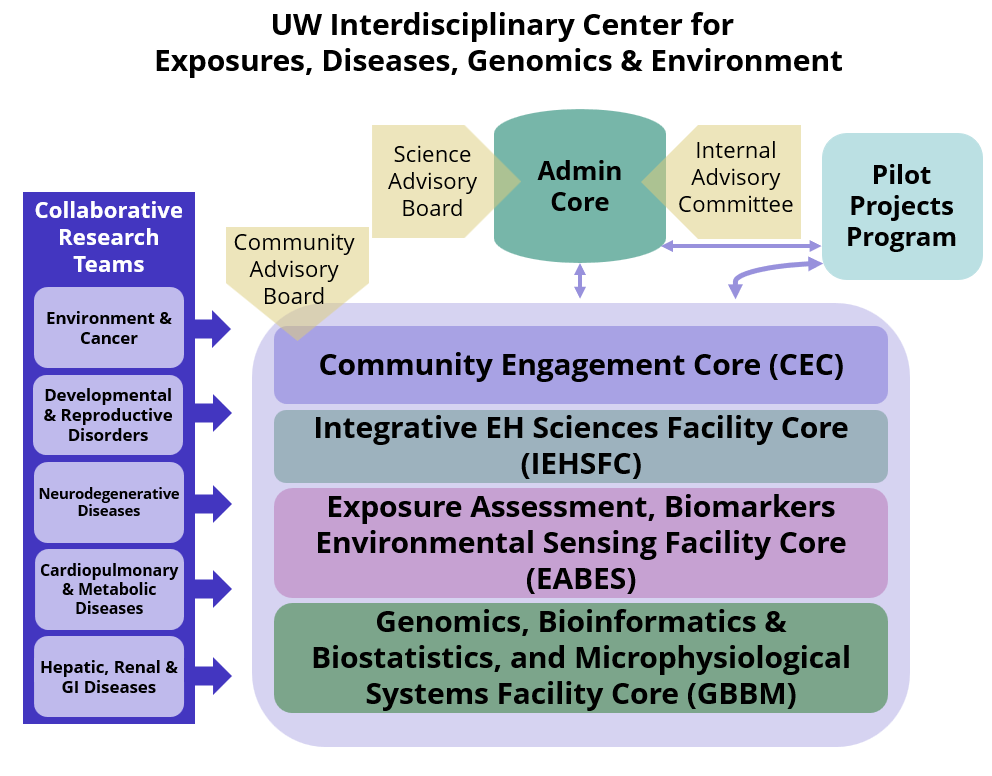The EDGE Center is transitioning to a new organizational structure that includes a Data Sciences Core and a Translational Research Support Core, with transition anticipated to be completed (dependent on funding) by April 2026.

The Center for Exposures, Diseases, Genomics & Environment (EDGE) acts as a nucleus for a wide range of UW grants and programs with missions relevant to gene-environment interactions.
Founded in 1995, EDGE strives to understand and communicate how genetic factors influence human susceptibility to environmental health risks. Researchers affiliated with the Center focus on the biochemical and molecular mechanisms underlying human variability in response to environmental exposures. The Center fosters collaborations between a large network of investigators working in toxicology, molecular biology, genetics, and environmental epidemiology, and includes a well-established Community Engagement Core (CEC) that has been serving K-12 educators, community groups, and the general public for over seventeen years.
The purpose of EDGE is to provide an administrative infrastructure and technical support to foster multidisciplinary collaborations between researchers. To this end, the Center is organized into five Collaborative Research Teams (CRTs). For the sake of clarity, faculty members affiliated with the Center are assigned to the CRT that most closely represents their primary area of research interest, although many have interests that cut across the various areas. The Center also provides members with valuable technical support through its four facility cores and a pilot projects program. Descriptions of these cores and the services they provide can be found on the Core Services page. The EDGE Center is transitioning to a new organizational structure, with transition anticipated to be completed (dependent on funding) by March 2026.
Dr. Joel Kaufman serves as the Principal Investigator and Director of the Center. The EDGE Center is supported by the National Institute of Environmental Health Sciences and is part of the Institute’s Environmental Health Sciences Core Center program, Grant #P30ES007033.
Science Advisory Board
We are very fortunate to have talented and dedicated individuals who help guide the work of the Center. The external Science Advisory Board is made up of current and past Directors or Core leaders of other National Institute of Environmental Health Sciences (NIEHS) Environmental Health Sciences (EHS) Core Centers. They attend our annual retreat and take part in an annual meeting to review our progress and make suggestions for new initiatives and improvements.
Melissa Bondy, PhD, Stanford School of Medicine
Deborah Cory-Slechta, PhD, University of Rochester Medical Center
Ana Navas-Acien, Columbia Mailman School of Public Health
Ivan Rusyn, MD, PhD, Texas A&M University
Michael Skinner, PhD, Washington State University
Robyn Tanguay, Oregon State University
Community Advisory Board
Our Community Engagement Core (CEC) is guided by input from our Community Advisory Board, which is centered around the three main areas of emphasis of our CEC including: Educators, Communication and Community Engagement, and Tribal Work. This board is made up of leaders in the community who represent the various stakeholder groups that the CEC serves.
Lindzee Alvarez, Interlake High School, Bellevue School District
Maria Batayola, Beacon Hill Council
Kelly Edwards, Room One
Rose James, Northwest Portland Area Indian Health Board
Bradley Kramer, Public Health – Seattle & King County
Paulina Lopez, Duwamish River Community Coalition
Liz Walker, Clean Air Methow
Contact us
University of Washington Center for Exposures, Diseases, Genomics & Environment
Department of Environmental and Occupational Health Sciences
Box 354695
Seattle, WA 98195-7234
206.616.5551
Email: edgectr@uw.edu
Shipping Address:
4225 Roosevelt Way NE, Suite 100
Seattle, WA. 98105-7234
Image Description: The EDGE Center structure chart shows the Admin Core at the top, advised by a Science Advisory Board and an Internal Advisory Committee. The Admin Core interacts with the Pilot Projects Program (shown in a box in the upper right) and with the four facility cores, shown in multi-colored stacked boxes: the Community Engagement Core (CEC); the Integrative EH Sciences Facility Core (IEHSFC); the Exposure Assessment, Biomarkers Environmental Sensing (EABES) Facility Core; and the Genomics, Bioinformatics and Biostatistics, and Microphysiological Systems Facility Core (GBBM). To the left is a bar containing the five Collaborative Research Teams (CRTs): environment and cancer; developmental and reproductive disorders; neurodegenerative diseases; cardiopulmonary and metabolic diseases; and hepatic, renal and GI diseases. The CRTs have arrows pointing towards the Core boxes. (Return to top of page.)